Very excited we are part of the largest charter yacht, M/Y Flying Fox!

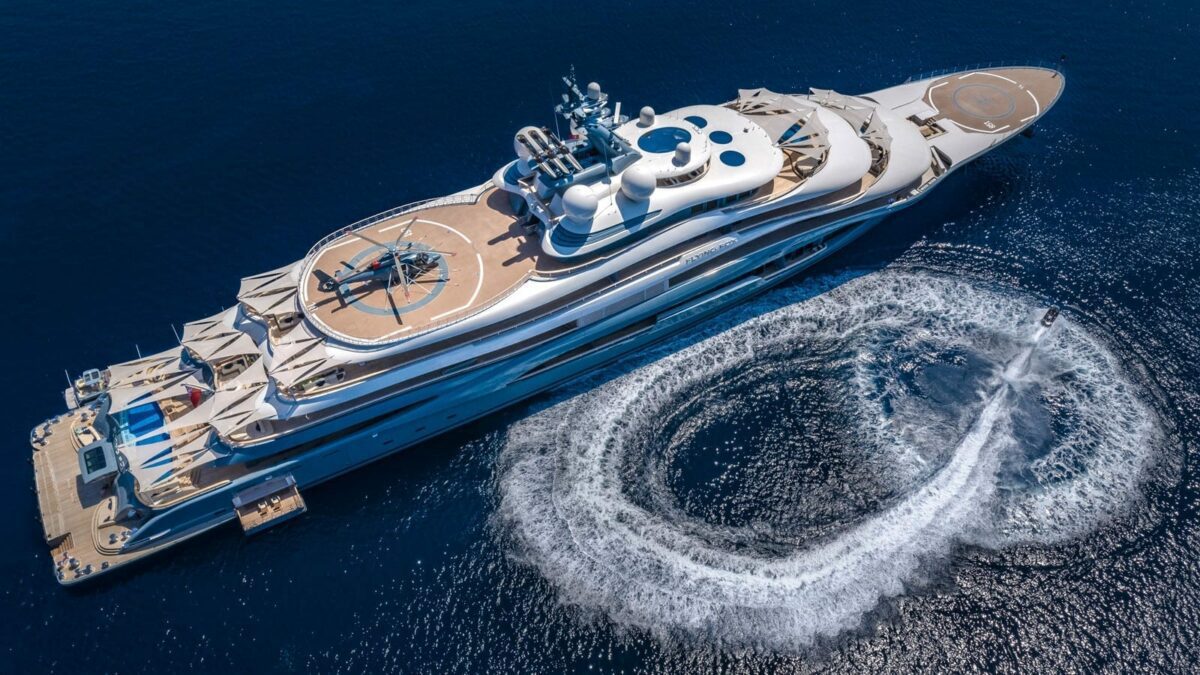
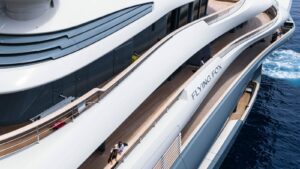
Flying Fox: Inside The World’s Largest Charter Yacht
Caroline White steps on board Flying Fox, the 136 metre superyacht by Lürssen and now the world’s largest yacht available for charter.
Flying Fox takes the freshest superyacht trends – and then pushes them to the limit. On a canvas of this scale, that’s fantastically far: the 136-metre, six-deck Lürssen yacht towers 32 metres above the waterline – as tall as three London buses balanced end on end – and has seized the crown as the world’s largest charter yacht.
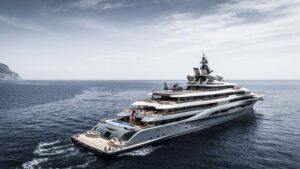
“If people tell you that we can create a brief for a 130-metre-plus project, I can tell you that’s totally wrong,” says Evgeniy Kochman, CEO of brokerage house Imperial, which acted as owner’s rep on the owner’s last superyacht project and shepherded Flying Fox from inception to completion. “Like every yacht, you start with a white sheet – but in this case you have many more spaces to t and to adapt to a very demanding, meticulous owner.”
Flying Fox’s 7,000 square metres of curving exterior by Espen Øino certainly contain a spectacular array of spaces, designed with originality by Øino, Mark Berryman and the owner, and executed with precision by Lürssen. The owner himself was deeply involved in every detail, “from the engine room to the observation deck”, says Kochman, who personally attended more than 50 meetings with the client, poring over the GA for an average of 14 hours at a time. Key to shaping the design was the owner’s experience on his previous fleet of superyachts. “It looked obvious to combine the facilities of them in one fully functional superyacht,” says Kochman.
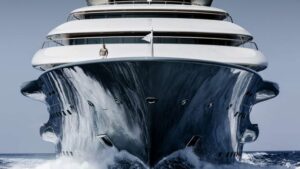
Looking at the finished arrangement, it is clear that the key takeaway from his other yachts has been a passion for watersports and wellness – which de nes this boat. It’s a modern preference re ected on many new yachts, but never before on this scale. The whole aft end of the yacht is a two-deck temple to on-water fun and relaxation. The tone is set when guests step on to the 22.5-metre-wide bathing platform and into one of the best superyacht spas to date. With heated limestone floors and louvred oak panelling, the centrepiece of this 400square-metre “sea lobby” is a vast spa pool, the waters of which can be changed from steaming to icy in about 10 minutes (thanks to dual hot and cold tanks) so it can be used as a plunge pool following the hammam or sauna.
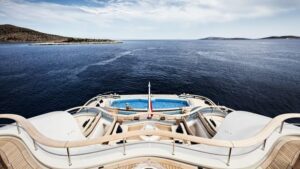
There’s also the rst cryosauna ever installed on a yacht. It comprises an antechamber at -60 ̊C, followed by a main chamber at -110 ̊C – you stay in for a maximum of three minutes and emerge with a post-sprint endorphin rush. It is popular with professional athletes to aid muscle regeneration and pain relief. “It is not so easy to come down to that temperature; normal air-conditioning cannot do this,” says Florian Preuss, project manager at Lürssen. “You need three compressors and three circuits – so you cool down three times; three independent systems, working in three steps.”
To starboard o the sea lobby lies a loungey relaxation room with a fold-down balcony. To port, the counterpart balcony sits between a kite surf store and a dive centre that will make enthusiasts swoon. There’s every bit of kit imaginable, from advanced nitrox mixing systems to full face masks and underwater scooters, plus a super-quiet compressor. “We can cater for anyone who has never dived before,” says the dive instructor. “We can start you up in the main swimming pool on the aft deck, all the way through to technical rebreather diving here – if we have certied clients on board, we can do expeditions down to 100 metres. We can do enriched air nitrox just for recreational diving or trimix as well.” In the boat’s hospital there’s also a “proper” decompression chamber.

The fun continues in the cavernous and innovative tender garage just forward, which holds ve tenders and a treasure trove of toys, from yboards and hoverboards to Seabobs and windsurfs. The space has also been specced to meet regulations for fuelling the tenders with petrol. “Quite a technical challenge to achieve that,” says the captain, “similar to what supertankers have.”
And there’s space for more. “We also investigated and prepared the tender garage to carry a personal submarine,” says Preuss. “So we installed an extra hatch in the tender garage so that you can go from the deck above into the submarine.” Because it’s shorter than a tender, launching it via the two sliding cranes designed to hitch each end of a boat would not work, “so we designed a special rack to put the submarine on, which can be picked up by the crane”.
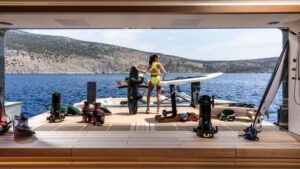
Aside from the tender garage, this spa and sports space is designed to feel cohesive – you can walk via side decks all the way round from the bathing platform to the fold-down terraces either side of the spa. Directly above the lower deck spa pool, meanwhile, a three-metre by three-metre section of deckhead slides into a forward pocket to create a two-deck atrium. Stainless-steel handrails are then erected around the gap on the main deck. When closed, as Preuss puts it, “you can walk over it as if it was not there”; open, it connects the lower and main decks in spectacular fashion.
The spa-like feeling is carried through this aft part of the main deck too. Just inside from the aft deck is a beauty centre, followed by a dry massage room – “We carry a lot of high-tech electrical equipment so we can do body-shaping and electrical facials, and we use highquality products by Swiss Perfection and Elemis,” says the therapist. There’s a wet massage room too, where “we do massages with the rain showers on, so you’re laid on a nice warm water bed, in a full shower”.
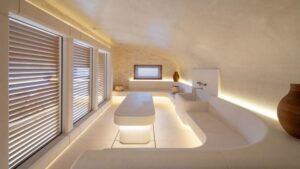
For more active guests there’s a standout superyacht gym packed with the latest Technogym kit, a balcony for fresh-air yoga and a gym “menu” laying out what’s on oer. It is staed by ex-British military instructors (of the supportive rather than the shouty kind) – in fact, all crew members are dual-trained in order to sta Flying Fox’s wellness and watersports components: for example, the medic is a dive instructor and some of the housekeepers are also hairdressers.
But the jewel in the crown of this whole two-deck space – at least technically – is the 12-metre aft deck pool. A 22.5-metre beam allowed the team to place this transversely. “It was the owner’s idea to do it in this direction and the rationale behind it was that it would take up less space,” says Øino. “If you were to orient it in the longitudinal direction it would overshoot big time into the deck house and the gym, so it was a very rational decision.”
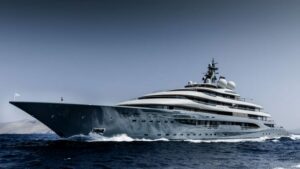
“I don’t think there is another project with a pool arranged this way,” adds Preuss. “And this is, of course, dicult from an engineering side because of the movement of the water – if the ship is rolling it is dicult to keep it in the pool.” The yard ordered extensive model testing at the University of Duisburg-Essen with a 1:10 scale model mounted on a pedestal that moved according to seakeeping analysis of the ship – so simulating real conditions. The yard identied the solution as two retractable baes that create a “gate” in the middle that breaks up the volume of water, so it can’t build up momentum. Crew can still empty the pool in three minutes, but there are fewer occasions when they will have to and therefore more times the pool can be used.
But all of this is nothing that guests would ordinarily see. What they will notice is the glass front that can be misted to opaque at the touch of a button, the swim jets at one end and the massage jets at the other, and the height-adjustable oor that means it can oer a deep swim, shallow paddle or even, at full height above the water, a bandstand for parties.
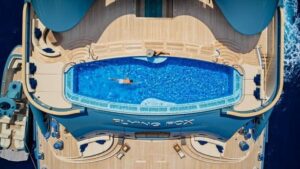
The 10 guest suites are ranged forward of the gym, so guests can pad straight from their beds for a workout or, further aft, a morning swim. These rooms are uniformly massive and each opens on to one of the long side decks, which can be separated into broad xed balconies in dierent congurations via hidden sliding panels (there are 45 sliding doors on Flying Fox). “We’ve carried families with the children in one suite and the parents in another, with this one big balcony for them. It works really well,” says the captain.
The decor here, as throughout the yacht, is, says Berryman, “clean-lined, contemporary”, functional and tactile, with Japanese inuences. The aim is a feeling of calm that ts perfectly with both the spa and the wider boat, with a small palette of colours, materials and nishes for a cohesive look – golden oak, caramel bamboo, brushed limestone, travertine marble and cream leather, as well as rattans and coconut shell embellishment.
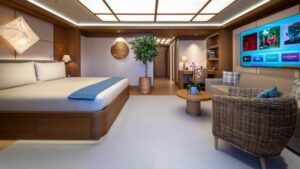
The upper deck master suite carries this pared-back look as well. There’s a 48-square-metre bathroom, centred with an oval bath and huge shower all ranged outboard, for the views through double-fronted sliding doors on to the broad private deck that wraps all the way around the front of the suite. Highlighting the decor is a delicate mosaic of corals and seaweeds at the back of the shower. “The owner has a love of mosaics,” says Berryman, noting that the 1,700-year-old Lod Mosaic found in Israel in 1996 was an inuence on their designs. “We also have them on the oors running throughout the main deck and the lower deck areas.” Created for Berryman by a specialist near Venice, they take on a playful character on the guest suite doors, each marked with a dierent sea creature.
The owner’s suite also comprises a beauty room and his-and-hers dressing rooms, but the cabin itself is the showstopper. “I have to say it was a dicult area to do,” says Berryman. “At 105 square metres you think, well, it’s a bedroom and you’ve got an aft saloon and aft dining room, what does he need out of it?” The solution was to place the bed to port and to create a cosy sitting room to starboard, complete with an ethanol replace.
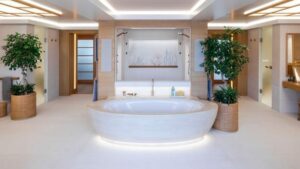
There are 180-degree windows and Øino replaced bulwarks with glass so that views could ow straight out to the seascape. Forward on the private terrace is a huge spa pool with sunpads and seating. Adjacent to the suite is a cluster of work-focused spaces – a meeting room and the owner’s oce, accessed through a studio. “The owner said to me early on, ‘I’m here to work, so I don’t want to be looking at the beautiful sea out there; let me face a wall and then I can concentrate,’” says Berryman.
But things get more social with one of the most extraordinary spaces on board. To port on the upper deck lies a loungey sitting room, for icking through magazines and, perhaps, waiting for a meeting in the oce. To starboard, the space drops o, behind glass balustrades, into a double-height saloon.

“Originally the upper deck saloon and dining was laid out to the port and starboard sides. After a few months of looking at those areas, we all felt the boat needed a wow factor,” says Berryman, “and also there was the saloon on the bridge deck – how many saloons did you actually need? So the starboard side upper dining was removed and the double-height space created.” The space is certainly wow-inducing and to avoid the feeling of, as Berryman puts it, “standing in the middle of a eld” the seating is grouped in the centre of the saloon, leaving a walkway of warm oak around the outside.
Also aiding a cosy feeling is the real-wood replace, one of five superyacht fireplaces on board. They work, as Preuss puts it, “like a normal replace at home” except with insulated ducts routing smoke up through the mast with the help of forced extraction, and measures to meet marine safety regulations. “The glass pane in front needs to be closed all the time and there is a shut-o mechanism,” says Preuss, adding that when you are dealing with unusual onboard technology, “regulations don’t exactly describe what is possible and what is not possible – you have to discuss a lot with the authorities to come to a good solution”.
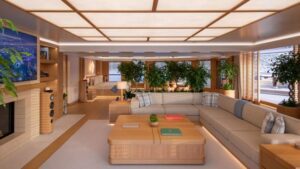
Another unusual – and residential – feature of the saloon is the greenery. It borders the staircase down from the upper deck and sprouts from planters set into the balustrade, while two cus trees tower in the outer corners of the space. “We have a full irrigation system on board that is then linked down to the engine control room so that you can keep a check on what is working and if there are any problems there,” says Berryman. The dierent watering schedules, nutrients and quantities for dierent plants are programmed in. There are also “specialised lighting systems to give them the correct amount of UV without bleaching the materials”, notes the captain.
Adjacent to the bridge deck saloon lies a dining saloon with a long table by Metrica (which made all the loose furniture on board). A central aquarium, lled with bright articial corals, adds a splash of colour while delineating the spaces (which can be entirely sequestered using sliding screens).
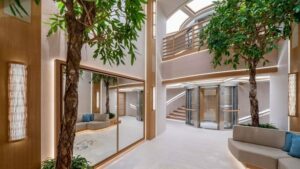
But just as the spectacular spa acknowledges the trend towards wellness, the yacht’s primary dining areas reect the modern preference for eating al fresco. “My own experience of cruising is that you always end up spending your time on the outside decks,” says Øino, “so actually moving the cooking outside is a very logical thing to do.” The outdoor kitchen on the bridge aft deck features a wok station, a Josper (coal-powered Spanish grill), a rotisserie capable of cooking a whole lamb, goat or suckling pig, a churrasco oven, pizza oven, teppanyaki and tandoori grill. Guests can sit at a counter and watch the chef work, or at an extendable dining table.
Aft, seating around a gas-fuelled repit oers the perfect nook for a nightcap. “Everyone says it has completely changed the dynamics of the boat, the interaction between the chef and the guests,” says Øino. “The chef is at the forefront and has become the star on board.” On the upper aft deck is a more intimate version of this space, which Øino describes as “more like a juice bar with ice cream and yoghurts”, as well as an outdoor cinema area and another firepit.
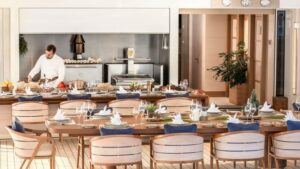
There are other noteworthy outdoor spaces. Take the helipad on the sundeck aft – it has an 18-metre D-value, capable of accommodating the world’s largest helicopters, including an Airbus H175. There are also power points and a DJ alcove built into the mast for when the helipad is used as a danceoor, and a neat waiting room for departing guests (there is also a foredeck helipad on the bridge deck, with a 14-metre D-value). Up top there’s a (relatively) petite roof deck, with the best views out to sea and also all the way down to the main deck, via the glass roof of the lift shaft. “Despite the very large size of the boat, it can sometimes be dicult nding intimate spaces away from everyone else,” says Øino. “But when you are on the top deck you know that you are on your own – it’s private there.”
The relaxed winter garden, meanwhile, is an indoor space that feels airy thanks to two huge openable, domed skylights made by Yachtglass. “They look light but the skylights are massive and actually very heavy so they were not easy to produce,” adds Preuss. “They needed a couple of tries.”
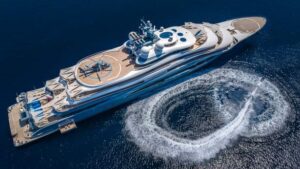
Perhaps the most surprising thing about this boat is that chartering was not among its primary aims. From the equally proportioned suites, to the neutral decor, massive spa, outdoor lifestyle and dynamic positioning, it seems as if she was built for it. There’s even a cinema with D-Box seating for the latest blockbusters with motion and vibrations (Lürssen had to box the room and add “many tonnes of steel”, says Preuss, to soundproof it). This really is a boat with the scope to oer something for everyone.
“Conceiving and building such yachts is not a quiet path for all parties involved,” notes Kochman with some understatement. “But seeing the pride in the eyes of our client at the delivery, of our build and operational team, and of the crew, reminds us why we do this job.” Now that the hard work is done, there’s nothing for the owner to do but sit back and enjoy the most relaxing boat afloat.
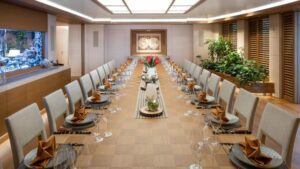
The Crew Cut
It takes a powerful “human engine” to run a boat like Flying Fox – and behind-the-scenes design to supercharge crew work. “We carry two galleys, one for guests and one for crew, and four chefs in total,” says the captain. “We have 55 crew to feed two, sometimes three hot meals.” With a full capacity of crew plus 25 guests, that’s 246 meals a day.
The guest galley is a cook’s fantasy. There’s a pasta machine and prep area with drying racks, a lobster tank for the freshest seafood, vacuum packing for tender steaks using a sous-vide water bath, Pacojet freezing blenders for silky purées and ice creams – and every other bit of kit you could imagine. The fridges and freezers on board measure a total of 137 cubic metres.
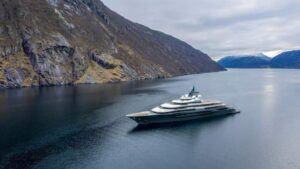
In terms of space to relax, “crew consideration was always in the middle of everything”, says Evgeniy Kochman. Aside from large cabins, lounge, mess and gym, crew have use of a comfortable outdoor lounge just behind the forward helipad – a request of the owner. The paperless wheelhouse is set up to handle anything the sea can throw at it. “The bridge splits into three key areas,” says the captain, “planning and communication, navigation and emergency response.” Recessed screens can completely isolate the emergency space.
“You allow the bridge ocers to continue with the navigation. They don’t get overawed with all the other communication going on, which could create another incident.” It’s a system common on cruise ships, not on yachts.